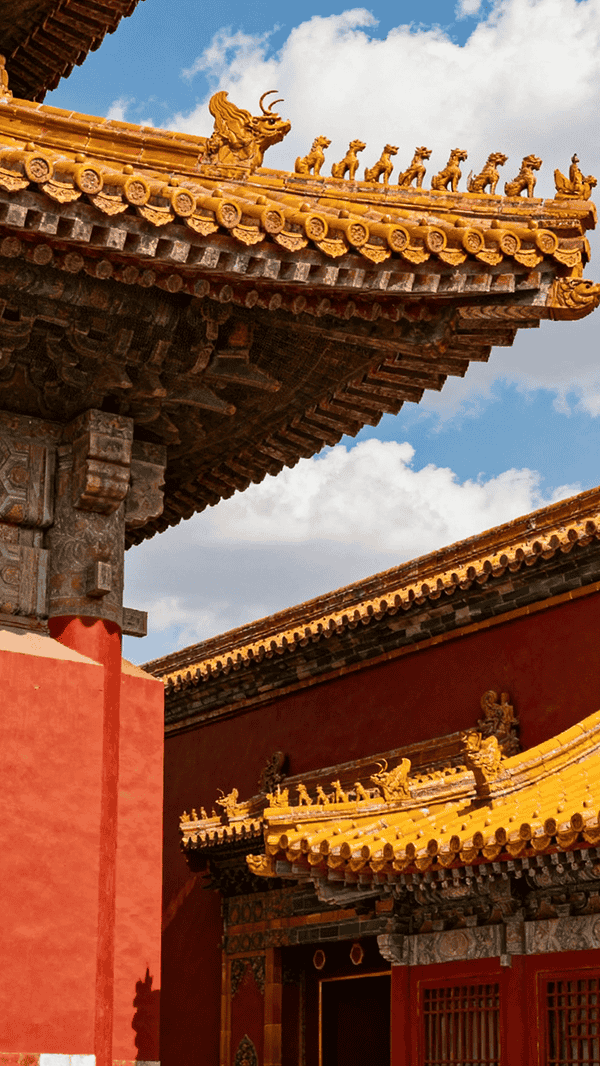In the heart of China’s capital, Beijing, stands a magnificent complex of royal architecture—the Forbidden City. Once the imperial palace of the Ming and Qing dynasties, formerly known as the “Purple Forbidden City,” it now opens its doors to the world as the “Palace Museum.” As one of the largest and most completely preserved ancient wooden structures in the world, the Forbidden City is not only the pinnacle of ancient Chinese palace architecture but also carries the profound memory of 5,000 years of Chinese civilization, serving as a cultural landmark that transcends time and space.
Construction of the Forbidden City began in the fourth year of the Yongle era of the Ming Dynasty (1406) and took 14 years to complete. Along with the Temple of Heaven, it was a core structure of Ming Dynasty Beijing. The entire complex spans approximately 720,000 square meters, with a built-up area of 150,000 square meters, housing over 9,000 palace rooms. Its layout strictly adheres to the traditional ritual norms of “central axis symmetry, with the court in front and living quarters in the rear.” A central axis running north-south divides the Forbidden City into eastern and western sections. Along this axis lie key structures such as the Meridian Gate, the Hall of Supreme Harmony, the Hall of Central Harmony, the Hall of Preserving Harmony, the Palace of Heavenly Purity, the Hall of Union, and the Palace of Earthly Tranquility. Flanking these are symmetrically arranged auxiliary buildings, including the Eastern and Western Six Palaces, the Hall of Literary Brilliance, and the Hall of Martial Valor. This layout forms a clear pattern of “state affairs in the front court and residence in the inner court,” perfectly reflecting the hierarchical order of “imperial supremacy” in ancient China.
The “face” of the Forbidden City is the Meridian Gate, its main entrance. Shaped like a “凹” character, it resembles a Vermilion Bird spreading its wings and is also known as the “Five Phoenix Tower.” The central passage of the Meridian Gate was reserved exclusively for the emperor, while the empress could pass through it only on her wedding day. Civil and military officials, along with royal clan members, had to use the side passages, reflecting the strict regulations that emphasized imperial dignity. Beyond the Meridian Gate lies the expansive Meridian Gate Square, with the Hall of Supreme Harmony—the core structure of the Forbidden City, commonly known as the “Hall of Golden Throne”—standing to the north. Perched on a three-tiered white marble Sumeru pedestal, the Hall of Supreme Harmony stands 26.92 meters tall and 63.96 meters wide, making it the largest and highest-ranking building in the Forbidden City. The hall is roofed with yellow glazed tiles, symbolizing imperial power, and features 3.4-meter-high chīwěn (ornamental roof figures) at either end of the main ridge. Inside, a gilded dragon throne sits at the center, beneath a plaque inscribed with the words “Jiàn Jí Suí Yóu” (“Establish the Ultimate, Succeed in Governance”), exuding imperial grandeur. During the Ming and Qing dynasties, the emperor held grand ceremonies here for major occasions such as enthronements, weddings, and the appointment of empresses, receiving homage from officials.
Beyond its grand palaces, the Forbidden City’s intricate details reveal exceptional craftsmanship. The palace ridges are adorned with various mythical creatures. The Hall of Supreme Harmony boasts ten such creatures—the most of any building in the Forbidden City—including the dragon, phoenix, lion, heavenly horse, sea horse, suānní, xiàyú, xièzhì, dǒuniú, and hángshí, each with its own auspicious meaning and symbolism. The floors of the Forbidden City are paved with “golden bricks,” which are not made of gold but from special Suzhou clay, fired through a complex process to achieve a stone-like hardness and a metallic ring when struck. These bricks remain intact even after 600 years. Additionally, the Forbidden City’s drainage system is a model of ancient hydraulic engineering. Open ditches and underground channels interconnect, with rainwater discharged through chīshǒu (ornamental gargoyles), enabling rapid drainage while creating the spectacular sight of “a thousand dragons spouting water,” showcasing the ingenuity of ancient craftsmen.
In 1925, the Forbidden City was officially converted into the Palace Museum, housing over 1.86 million cultural relics, including bronzes, ceramics, calligraphy, paintings, jades, and clocks. Among these treasures are national gems such as “A Thousand Li of Rivers and Mountains” and “Along the River During the Qingming Festival.” In 1987, the Forbidden City was inscribed on the UNESCO World Heritage List, with the evaluation: “The Imperial Palace of the Ming and Qing Dynasties in Beijing, known as the Forbidden City, was the supreme power center in China for over five centuries. With its landscaped gardens and a vast complex of over 9,000 rooms containing furniture and artworks, it provides an invaluable testimony to Chinese civilization during the Ming and Qing dynasties.” Today, the Palace Museum revitalizes ancient culture through digital exhibitions and cultural creative products, attracting tens of millions of visitors each year to experience the grandeur of the imperial palace and the charm of ancient civilization.
From a forbidden imperial enclave to a cultural Hall, the Forbidden City has weathered 600 years of history, standing firm on the land of China. It is not only an architectural treasure but also a living history textbook, narrating the splendor and wisdom of ancient China to the world while embodying the Chinese nation’s relentless pursuit of cultural heritage and innovation.
